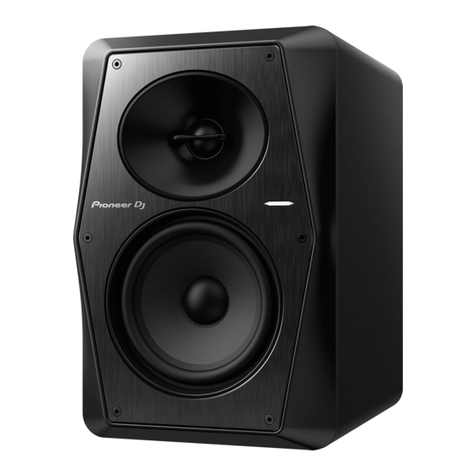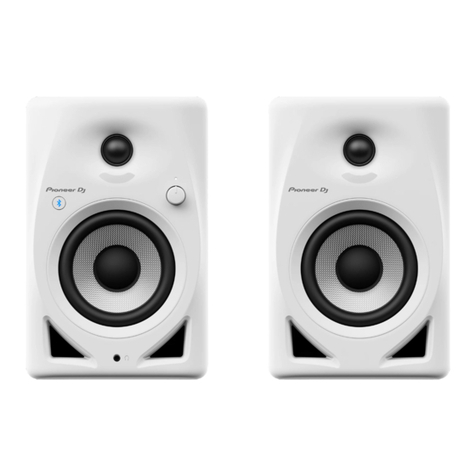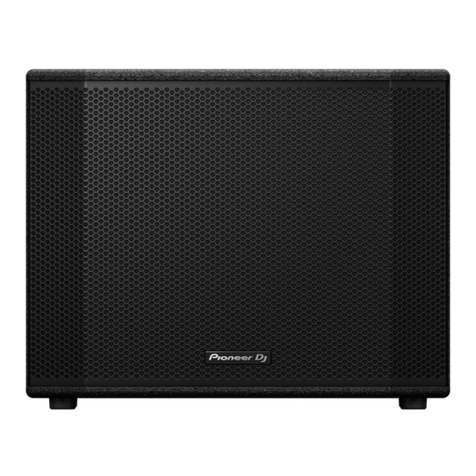
En
8
Listening to the Music of a Bluetooth Device
These speakers allow you to wirelessly enjoy tracks saved to a Bluetooth device.
When using the speakers for the first time or when connecting a new Bluetooth device to the speakers, you need to pair the speakers and Bluetooth
device.
Pairing (device mutual registration) is the operation required to connect a Bluetooth device and the speakers.
!Microwave-based health aids
!Some baby monitors
Other, less common, equipment that may operate on the same
frequency:
!Anti-theft systems
!Amateur radio stations (HAM)
!Warehouse logistic management systems
!Discrimination systems for train or emergency vehicles
CAUTION
!In the event noise appears in your television image, there is the
possibility that a Bluetooth device or this unit (including products
supported by this unit) are causing signal interference with the
antenna input connector of your television, video, satellite tuner,
etc. In this event, increase the distance between the antenna input
connector and the Bluetooth device or this unit (including prod-
ucts supported by this unit).
!If there is something obstructing the path between this unit
(including devices supported by this unit) and the device equipped
with Bluetooth wireless technology (such as a metal door, concrete
wall, or insulation containing tinfoil), you may need to change the
location of your system to prevent signal noise and interruptions.
Scope of operation
Use of this unit is limited to home use. (Transmission distances may be
reduced depending on communication environment).
In the following locations, poor condition or inability to receive radio
waves may cause the audio to be interrupted or stopped:
!In reinforced concrete buildings or steelframed or ironframed
buildings.
!Near large metallic furniture.
!In a crowd of people or near a building or obstacle.
!In a location exposed to the magnetic field, static electricity or radio
wave interference from radio communication equipment using the
same frequency band (2.4 GHz) as this unit, such as a 2.4 GHz wire-
less LAN device or microwave oven.
!If you live in a heavily populated residential area (apartment, town-
house, etc.) and if your neighbor’s microwave is placed near your
system, you may experience radio wave interference. If this occurs,
move your unit to a different place. When the microwave is not in
use, there will be no radio wave interference.
Radio wave reflections
The radio waves received by this unit include the radio wave coming
directly from the device equipped with Bluetooth wireless technology
(direct wave) and waves coming from various directions due to reflec-
tions by walls, furniture and building (reflected waves). The reflected
waves (due to obstacles and reflecting objects) further produce a variety
of reflected waves as well as variation in reception condition depending
on locations. If the audio cannot be received properly due to this phe-
nomenon, try moving the location of the device equipped with Bluetooth
wireless technology a little. Also note that audio may be interrupted
due to the reflected waves when a person crosses or approaches the
space between this unit and the device equipped with Bluetooth wireless
technology.
Pairing and Connection Procedure
1 Turn on the [POWER] switch to power on the
speakers.
!The Bluetooth indicator flashes for approximately 30 seconds and the
speakers enter the pairing state.
!If the Bluetooth indicator is off, press the pairing button for at least 2
seconds to switch to the pairing state again.
2 Perform the pairing operation on the Bluetooth
device.
Perform the operation while the speakers are in the pairing state. For
details, see the operating instructions of your Bluetooth device.
3 When the Bluetooth indicator changes from the
flashing to lit state, pairing (connecting) is complete.
If pairing could not be performed within 30 seconds, the Bluetooth indi-
cator changes from the flashing to off state.
!A Bluetooth device that has already been paired can be connected by
performing the connection operation on the Bluetooth device side if
the speakers are powered on.
Playback
When you play music on a connected Bluetooth device, the music play-
ing on the Bluetooth device is output from the speakers.
!Pressing the pairing button during music playback on the Bluetooth
device allows you to perform the pause/play operation (same func-
tion as the pause/play button of the Bluetooth device).
CAUTION
!When pairing (connecting), move the Bluetooth device close to the
speakers.
!Loud sound may be output when the playback operation is per-
formed for the first time after connecting completes so we recom-
mend lowering the volume before playback.
!The pause/play operation may not be possible with the pairing but-
ton depending on the application used.
!Connecting with the speakers may not be possible depending on
the Bluetooth device.
!If you wish to pair the speakers with a different Bluetooth device,
turn off the Bluetooth function of the currently connected
Bluetooth device or disconnect the connection before performing
the pairing operation.
!The speakers store the pairing information of up to eight Bluetooth
devices, and attempt to connect to the last paired device if the pair-
ing button is pressed in the state of no connection with a Bluetooth
device.
Radiowavecaution
Radio wave caution
This unit uses a 2.4 GHz radio wave frequency, which is a band used by
other wireless systems (see list below). To prevent noise or interrupted
communication, do not use this unit nearby such devices, or make sure
these devices are switched off during use.
!Cordless phones
!Cordless facsimiles
!Microwave ovens
!Wireless LAN devices (IEEE802.11b/g)
!Wireless AV equipment
!Wireless controllers for game systems





































